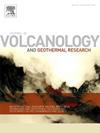Effect of local topography/structure on lava flow direction: A view from Ananthagiri Hills from Deccan Basalts, India
IF 2.3
3区 地球科学
Q2 GEOSCIENCES, MULTIDISCIPLINARY
Journal of Volcanology and Geothermal Research
Pub Date : 2025-07-07
DOI:10.1016/j.jvolgeores.2025.108408
引用次数: 0
Abstract
Deccan Trap lavas may have erupted through multiple centers, the most prominent of which may have been a shield volcano-like structure in the Western Ghats. The lava transportation and emplacement mechanism provides crucial information on the source and how lava is associated with crustal rocks. Here, we present the results of Anisotropy of magnetic susceptibility (AMS), rock magnetism, and petrology to understand the lava flow directions of Deccan basalts at Ananthagiri Hills. We collected 48 oriented block rock samples from 6 sites and prepared 432 specimens for the detailed investigation. Rock magnetic study indicates that the Pseudo-single domain of titanomagnetite is the primary carrier magnetic mineral. Under the microscope, the volcanic rocks of the Ananthagiri predominantly contain plagioclase and pyroxene phenocrysts that are surrounded by plagioclase, pyroxene, and other opaques, including magnetite and titanomagnetite in the matrix. The AMS principal susceptibility axes are closely clustered with well-developed magnetic lineation and foliation. The magnetic lineation (K1) aligns best with microscopic flow indicators along NE-SW, indicating the lava flow direction. The pole of magnetic foliation (K3) clustered at the center with an almost sub-vertical direction, whereas K1 and K2 are shallow plunging NE-SW and NW-SE directed, respectively. The degree and shape parameters indicate a mixed oblate and prolate nature; most sites are oblate. Based on all these observations, it is inferred that the local paleo-topography and structures before the Deccan eruption at ∼65 Ma in the basement Dharwar craton affect the lava flow in the study region with an anomalous SW-directed flow.

局部地形/结构对熔岩流动方向的影响:从印度德干玄武岩的Ananthagiri山看
德干圈闭熔岩可能通过多个中心喷发,其中最突出的可能是西高止山脉的一个类似盾状火山的结构。熔岩运移和侵位机制为研究岩浆的来源以及熔岩与地壳岩石的关系提供了重要信息。在此,我们利用磁化率各向异性、岩石磁性和岩石学的结果来了解Ananthagiri山德干玄武岩的熔岩流动方向。我们从6个地点采集了48个定向块岩样品,并准备了432个样品进行详细调查。岩石磁性研究表明,钛磁铁矿的拟单畴是主要的载磁性矿物。在显微镜下,Ananthagiri的火山岩主要含有斜长石和辉石斑晶,这些斑晶被斜长石、辉石和其他不透明物包围,包括基质中的磁铁矿和钛磁铁矿。AMS主磁化率轴紧密聚集,磁线理和片理发育。磁线理(K1)与NE-SW方向的微观流动指标最吻合,指示岩浆流动方向。磁片理极(K3)以近亚垂直方向聚集在中心,而K1和K2分别为NE-SW和NW-SE方向的浅倾。度和形状参数显示为扁圆和长形混合;大多数站点是扁圆的。综合以上观测结果,推测在德干火山喷发前的古地形和构造对研究区基底Dharwar克拉通的熔岩流产生了异常的西向流动的影响。
本文章由计算机程序翻译,如有差异,请以英文原文为准。
求助全文
约1分钟内获得全文
求助全文
来源期刊
CiteScore
5.90
自引率
13.80%
发文量
183
审稿时长
19.7 weeks
期刊介绍:
An international research journal with focus on volcanic and geothermal processes and their impact on the environment and society.
Submission of papers covering the following aspects of volcanology and geothermal research are encouraged:
(1) Geological aspects of volcanic systems: volcano stratigraphy, structure and tectonic influence; eruptive history; evolution of volcanic landforms; eruption style and progress; dispersal patterns of lava and ash; analysis of real-time eruption observations.
(2) Geochemical and petrological aspects of volcanic rocks: magma genesis and evolution; crystallization; volatile compositions, solubility, and degassing; volcanic petrography and textural analysis.
(3) Hydrology, geochemistry and measurement of volcanic and hydrothermal fluids: volcanic gas emissions; fumaroles and springs; crater lakes; hydrothermal mineralization.
(4) Geophysical aspects of volcanic systems: physical properties of volcanic rocks and magmas; heat flow studies; volcano seismology, geodesy and remote sensing.
(5) Computational modeling and experimental simulation of magmatic and hydrothermal processes: eruption dynamics; magma transport and storage; plume dynamics and ash dispersal; lava flow dynamics; hydrothermal fluid flow; thermodynamics of aqueous fluids and melts.
(6) Volcano hazard and risk research: hazard zonation methodology, development of forecasting tools; assessment techniques for vulnerability and impact.

 求助内容:
求助内容: 应助结果提醒方式:
应助结果提醒方式:


